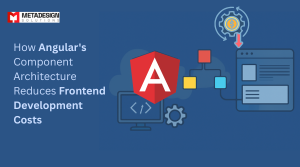Ever found yourself knee-deep in Angular code, thinking “there’s got to be a simpler way to add AI capabilities without losing my mind”? You’re not alone. Thousands of developers struggle daily with the complexity of integrating AI into otherwise solid Angular applications.
I’m about to show you how building AI-integrated apps with Angular and OpenAI APIs—backed by expert Angular development services—can transform your development process from frustrating to flowing in under an hour. The secret isn’t in completely overhauling your existing Angular architecture. It’s about finding the right connection points where OpenAI’s powerful APIs can plug in seamlessly.But here’s what most tutorials won’t tell you about this integration – there’s a specific pattern that separates the apps that merely function from those that actually impress users and clients. And it’s simpler than you might think.Understanding AI Integration
Fundamentals
Key benefits of combining Angular with AI capabilities
Angular isn’t just another JavaScript framework—it’s your secret weapon when building AI-powered applications. Why? Because Angular’s component-based architecture fits perfectly with modular AI features. You can isolate AI functionality in dedicated components while keeping your app structure clean.The real magic happens with Angular’s reactive programming model. When an AI model returns predictions or generates content, RxJS observables handle those asynchronous responses beautifully—no callback hell, just clean, maintainable code.Ever tried implementing real-time AI features? Angular’s change detection makes UI updates seamless when AI responses stream in. Plus, Angular’s TypeScript foundation gives you strong typing for those complex AI response objects. Trust me, you’ll thank yourself later when debugging.Teams love how Angular’s dependency injection simplifies testing AI integrations. You can mock OpenAI API responses without making actual API calls during tests. That saves money and keeps tests reliable.Overview of OpenAI’s API ecosystem
OpenAI’s API ecosystem is more than just ChatGPT. It’s a whole playground of AI capabilities ready to supercharge your Angular apps.The GPT models (3.5-turbo, 4) handle natural language processing tasks from summarization to content generation. But don’t sleep on DALL-E for image generation or Whisper for speech-to-text conversion.| Model | Primary Use Case | Best For |
|---|---|---|
| GPT-4 | Advanced reasoning | Complex interactions |
| GPT-3.5 | General text generation | Cost-effective chatbots |
| DALL-E | Image creation | Visual content |
| Whisper | Audio transcription | Speech interfaces |
| Embeddings | Text similarity | Recommendation systems |
Setting up your development environment
Getting your Angular environment ready for AI integration isn’t rocket science.First, create a new Angular project if you don’t have one:
ng new ai-angular-app
cd ai-angular-app
Install the OpenAI Node.js package:
npm install openai
Create an environment file to store your API keys safely:
// environment.ts
export const environment = {
production: false,
openaiApiKey: 'your-api-key-here'
};
Add that file to .gitignore immediately! Never commit API keys.
Set up an API service to handle OpenAI requests:
ng generate service services/openai
Now configure a proxy in your Angular app to avoid CORS issues:
// proxy.conf.json
{
"/api": {
"target": "https://api.openai.com",
"secure": true,
"changeOrigin": true,
"pathRewrite": {
"^/api": "/v1"
}
}
}
Essential AI concepts for frontend developers
Frontend devs don’t need PhD-level AI knowledge, but understanding some core concepts will save you headaches.
Tokens are the currency of AI models—they’re chunks of text (not always whole words) that models process. A token is roughly 4 characters in English. This matters because API pricing and context windows are measured in tokens.
Prompt engineering is an art form. The difference between a great and mediocre AI feature often comes down to how you structure your prompts. Be specific, provide examples, and set constraints.
Temperature controls randomness in responses. Lower values (0.2) give predictable outputs, while higher values (0.8) produce creative but sometimes unpredictable results. For most Angular applications, start with low temperatures for consistent UI experiences.
Context windows limit how much text a model can “remember” during a conversation. GPT-3.5 handles about 4,000 tokens while GPT-4 manages 8,000+ tokens. Plan your app’s conversation flow accordingly.
Rate limiting will affect your application architecture. OpenAI limits requests per minute, so implement queuing for high-traffic applications or you’ll face failed API calls.
Ready to Fortify Your Salesforce Environment?
At MetaDesign Solutions, our expert team specializes in crafting intelligent, scalable applications by seamlessly integrating OpenAI APIs with Angular. Let us turn your AI vision into a powerful digital experience.
Getting Started with Angular and OpenAI
A. Creating a new Angular project structure
Getting your Angular project up and running is pretty straightforward. Fire up your terminal and run:
npm install -g @angular/cli
ng new ai-powered-app
cd ai-powered-app
This creates a fresh Angular project with all the standard folders. For our OpenAI integration, we’ll need to add a few extra pieces:
src/
├── app/
│ ├── components/
│ │ └── ai-chat/
│ ├── services/
│ │ └── openai.service.ts
│ └── models/
│ └── openai-response.model.ts
└── environments/
├── environment.ts
└── environment.prod.ts
B. Installing necessary dependencies
Time to beef up our project with the right packages:
npm install openai axios rxjs
The OpenAI package gives us the client SDK, axios handles HTTP requests smoothly, and RxJS helps manage asynchronous operations when dealing with API responses.
C. Setting up OpenAI API authentication
Creating an authentication setup for OpenAI is surprisingly simple. First, grab your API key from the OpenAI dashboard. Then, create an OpenAI service:
import { Injectable } from '@angular/core';
import { Configuration, OpenAIApi } from 'openai';
import { environment } from 'src/environments/environment';
@Injectable({
providedIn: 'root'
})
export class OpenAiService {
private openai: OpenAIApi;
constructor() {
const configuration = new Configuration({
apiKey: environment.openaiApiKey,
});
this.openai = new OpenAIApi(configuration);
}
}
D. Implementing environment configurations for API keys
Never hard-code your API keys! Set up your environment files properly:
// environment.ts
export const environment = {
production: false,
openaiApiKey: 'your-development-api-key'
};
// environment.prod.ts
export const environment = {
production: true,
openaiApiKey: 'your-production-api-key' // Use environment variables in production
};
In real production, you’d want to inject these values during your build process or server-side.
E. Creating reusable AI service components
Now for the fun part – building a service that any component can use:
// openai.service.ts
import { Injectable } from '@angular/core';
import { Observable, from } from 'rxjs';
import { environment } from 'src/environments/environment';
import { Configuration, OpenAIApi } from 'openai';
@Injectable({
providedIn: 'root'
})
export class OpenAiService {
private openai: OpenAIApi;
constructor() {
const configuration = new Configuration({
apiKey: environment.openaiApiKey,
});
this.openai = new OpenAIApi(configuration);
}
generateText(prompt: string): Observable<string> {
return from(this.callOpenAI(prompt));
}
private async callOpenAI(prompt: string): Promise<string> {
const response = await this.openai.createCompletion({
model: 'text-davinci-003',
prompt,
max_tokens: 150,
temperature: 0.7
});
return response.data.choices[0].text.trim();
}
}
Building Intelligent User Interfaces
Designing intuitive AI-powered components
Ever tried explaining to someone what an AI component actually does? It’s like trying to explain why avocado toast costs $15. But here’s the deal – your users shouldn’t need that explanation.
The best AI components hide their complexity behind simple interfaces. Think about how Netflix recommends shows – you don’t see the algorithm, just the results. That’s your goal.
Start with familiar patterns. A chatbot should still look like a chat interface. A text generator should have a clear input and output area. Don’t reinvent the wheel just because AI is involved.
Visual cues matter enormously. Use subtle animations to show when AI is “thinking.” Add confidence indicators for predictions. Color-code AI suggestions differently from user input.
@Component({
selector: 'ai-suggestion',
template: `
<div class="suggestion" [class.high-confidence]="confidence > 0.8">
{{ text }} <span class="confidence">{{ confidence | percent }}</span>
</div>
`
})
Always give users an escape hatch. Every AI interaction should have an obvious way to reject suggestions or revert to manual mode.
Implementing real-time text completion features
Text completion is the gateway drug of AI features. Users get it instantly, and once they experience that magic moment of the app completing their thought, they’re hooked.
The trick is nailing the timing. Complete too early, you interrupt their flow. Too late, and they’ve already finished typing. The sweet spot? About 300-500ms after they pause typing.
Here’s how you wire it up in Angular:
@Component({
selector: 'smart-input',
template: `<textarea [(ngModel)]="text" (ngModelChange)="onTextChange()"></textarea>`
})
export class SmartInputComponent {
@Output() completionSuggested = new EventEmitter<string>();
private textChangeSubject = new Subject<string>();
ngOnInit() {
// Wait for typing pause before suggesting
this.textChangeSubject.pipe(
debounceTime(400),
distinctUntilChanged(),
switchMap(text => this.openaiService.getSuggestion(text))
).subscribe(suggestion => {
this.completionSuggested.emit(suggestion);
});
}
onTextChange() {
this.textChangeSubject.next(this.text);
}
}
Don’t show the full completion right away. Start with 2-3 words and let users hit Tab to accept. This feels collaborative rather than intrusive.
Creating dynamic form validation with AI assistance
Form validation that only catches errors after submission is like telling someone they’re wearing mismatched socks after they’ve left the house. Too late, too annoying.
AI validation changes the game. Instead of rigid rules, you can actually understand what users are trying to do.
For example, traditional validation might reject “123 Main St Apt #2” because it doesn’t match a pattern. AI validation understands it’s a valid address with an apartment number.
The implementation is surprisingly straightforward:
validateAddress(control: FormControl) {
return this.openaiService.validateAddress(control.value).pipe(
map(result => {
if (!result.valid) {
return { invalidAddress: result.reason };
}
// Smart correction
if (result.suggestion && result.confidence > 0.9) {
control.setValue(result.suggestion);
}
return null;
})
);
}
Pro tip: Use AI validation as a second pass after basic validation. Check required fields and formats with standard validators, then use AI for the semantic validation.
Optimizing user experience with predictive inputs
Predictive inputs are what separate good apps from great ones. They feel like magic when done right.
Take date inputs. Instead of making users type “2023-11-15”, let them type “next Friday” or “two weeks from today” and convert it automatically.
The key is context awareness. If a user is booking a flight to Paris, suggest Paris attractions in the next input field. If they’re shopping for hiking gear, suggest trails near their location.
@Component({
selector: 'smart-search',
template: `
<input [(ngModel)]="query" (ngModelChange)="updatePredictions()">
<div class="predictions">
<div *ngFor="let prediction of predictions"
(click)="selectPrediction(prediction)">
{{ prediction.text }}
</div>
</div>
`
})
The real power comes from combining multiple signals. Location + time of day + previous behavior = scary-good predictions.
But remember – predictive isn’t perfect. Always design for graceful failures. When the AI gets it wrong (and it will), make it trivial for users to correct course without frustration.
Implementing Natural Language Processing Features
A. Building a smart chatbot interface
Ever tried building a chatbot that doesn’t make users want to throw their device across the room? Angular and OpenAI’s APIs make this dream actually achievable.
Start with the basics – create a simple chat component:
@Component({
selector: 'app-chatbot',
template: `
<div class="chat-container">
<div class="messages">
<div *ngFor="let msg of messages" [class]="msg.sender">
{{ msg.text }}
</div>
</div>
<input [(ngModel)]="userInput" (keyup.enter)="sendMessage()">
<button (click)="sendMessage()">Send</button>
</div>
`
})
The magic happens when you connect to OpenAI:
async sendMessage() {
// Add user message to chat
this.messages.push({sender: 'user', text: this.userInput});
// Call OpenAI API
const response = await this.openaiService.createCompletion({
model: "gpt-3.5-turbo",
messages: this.buildConversationHistory()
});
// Add AI response
this.messages.push({sender: 'bot', text: response.choices[0].message.content});
this.userInput = '';
}
What makes your chatbot actually smart? Context tracking. Don’t just send single messages – maintain conversation history and persona instructions.
B. Adding sentiment analysis to user feedback forms
Wouldn’t it be nice to know how your users actually feel without having to read hundreds of comments?
Here’s a quick implementation:
async analyzeSentiment(feedback: string) {
const prompt = `Analyze the sentiment of this feedback.
Return only "positive", "negative", or "neutral": "${feedback}"`;
const response = await this.openaiService.createCompletion({
model: "gpt-3.5-turbo",
messages: [{role: "user", content: prompt}],
max_tokens: 10
});
return response.choices[0].message.content.trim().toLowerCase();
}
Then visualize it:
<div class="feedback-sentiment" [ngClass]="feedbackSentiment">
<span *ngIf="feedbackSentiment === 'positive'">😊</span>
<span *ngIf="feedbackSentiment === 'negative'">😞</span>
<span *ngIf="feedbackSentiment === 'neutral'">😐</span>
</div>
Pro tip: batch your API calls. Don’t hit OpenAI for every single feedback item in real-time. Collect them and analyze in groups to save costs.
C. Creating content summarization components
Content overload is real. Give your users a break with smart summarization.
First, create a directive:
@Directive({
selector: '[appSummarize]'
})
export class SummarizeDirective {
@Input() originalContent: string;
@Output() summarized = new EventEmitter<string>();
@HostListener('click')
async summarize() {
if (this.originalContent.length < 100) {
return; // No need to summarize short content
}
const summary = await this.aiService.getSummary(this.originalContent);
this.summarized.emit(summary);
}
}
Use it like this:
<article>
<p>{{ showFullContent ? fullArticle : summarizedContent }}</p>
<button appSummarize [originalContent]="fullArticle"
(summarized)="summarizedContent = $event">
{{ showFullContent ? 'Show Summary' : 'Show Full Content' }}
</button>
</article>
For best results, include instructions in your prompt about the desired length and style of the summary.
D. Implementing language translation services
Breaking language barriers isn’t just for sci-fi anymore. OpenAI’s models handle translation remarkably well.
Create a translation service:
@Injectable()
export class TranslationService {
constructor(private openai: OpenAIService) {}
async translate(text: string, targetLanguage: string): Promise<string> {
const prompt = `Translate the following text to ${targetLanguage}: "${text}"`;
const response = await this.openai.createCompletion({
model: "gpt-3.5-turbo",
messages: [{role: "user", content: prompt}]
});
return response.choices[0].message.content;
}
}
Add a language selector component:
<div class="language-selector">
<select [(ngModel)]="selectedLanguage" (change)="translateContent()">
<option value="Spanish">Spanish</option>
<option value="French">French</option>
<option value="German">German</option>
</select>
</div>
Cache translated content to avoid repeated API calls for the same text.
E. Enhancing search functionality with semantic understanding
Regular keyword search is so 2010. Semantic search understands what users mean, not just what they type.
async semanticSearch(query: string, documents: string[]): Promise<string[]> {
// Get embedding for query
const queryEmbedding = await this.getEmbedding(query);
// Compare with document embeddings
const results = [];
for (const doc of documents) {
const docEmbedding = await this.getEmbedding(doc);
const similarity = this.cosineSimilarity(queryEmbedding, docEmbedding);
results.push({doc, similarity});
}
// Return sorted results
return results
.sort((a, b) => b.similarity - a.similarity)
.map(result => result.doc);
}
This approach finds results based on meaning, not just keywords. So when someone searches for “affordable laptops,” your search also returns results about “budget computers” and “inexpensive notebooks.”
Working with OpenAI’s Image Generation Capabilities
Integrating DALL-E Image Generation API
Ever tried explaining what’s in your head to a designer? It’s like trying to describe a color to someone who’s never seen it. That’s where DALL-E comes in clutch for Angular developers.
First, you’ll need to set up your OpenAI API connection:
import { Injectable } from '@angular/core';
import { HttpClient, HttpHeaders } from '@angular/common/http';
import { environment } from '../environments/environment';
@Injectable({
providedIn: 'root'
})
export class OpenAiService {
constructor(private http: HttpClient) {}
generateImage(prompt: string) {
const headers = new HttpHeaders()
.set('Content-Type', 'application/json')
.set('Authorization', `Bearer ${environment.openaiApiKey}`);
return this.http.post('https://api.openai.com/v1/images/generations', {
prompt: prompt,
n: 1,
size: "1024x1024"
}, { headers });
}
}
Don’t forget to guard your API key in an environment file. Your wallet will thank you.
Building an Image Creation Interface
The interface doesn’t have to be rocket science. A simple form with a text area and a button can work wonders:
<form [formGroup]="imageForm" (ngSubmit)="onSubmit()">
<textarea
formControlName="prompt"
placeholder="Describe the image you want to create..."
rows="4">
</textarea>
<button type="submit" [disabled]="loading">
{{ loading ? 'Generating...' : 'Create Image' }}
</button>
</form>
<div *ngIf="generatedImage" class="image-container">
<img [src]="generatedImage" alt="AI-generated image">
</div>
In your component, hook everything up:
imageForm.invalid) return;
this.loading = true;
this.openAiService.generateImage(this.imageForm.value.prompt)
.subscribe(
(response: any) => {
this.generatedImage = response.data[0].url;
this.loading = false;
},
error => {
console.error('Error generating image:', error);
this.loading = false;
}
);
}
Implementing Image Variation Components
Generating variations takes your app to the next level. Once you’ve got an image, why not let users explore different versions?
createVariation(imageUrl: string) {
// First, convert the image URL to a base64-encoded file
this.fetchAndConvertImage(imageUrl).then(base64Image => {
this.openAiService.createImageVariation(base64Image)
.subscribe(
(response: any) => {
this.variations = response.data.map(item => item.url);
}
);
});
}
Add a UI component to display these variations in a grid or carousel:
<div class="variation-controls">
<button (click)="createVariation(generatedImage)" [disabled]="!generatedImage">
Show me different versions
</button>
</div>
<div class="variations-grid" *ngIf="variations.length > 0">
<div class="variation" *ngFor="let var of variations">
<img [src]="var" alt="Image variation">
<button (click)="selectVariation(var)">Use this</button>
</div>
</div>
Advanced State Management for AI Applications
Managing API response states efficiently
Working with AI APIs can be messy. One second your app is humming along, the next it’s hanging because OpenAI is thinking about your prompt.
Here’s the deal: you need a solid state management approach. Angular developers often reach for NgRx, but that’s overkill for many AI-integrated apps. Instead, try this pattern:
enum ResponseState {
IDLE,
LOADING,
SUCCESS,
ERROR
}
@Injectable()
export class AIService {
private responseState = new BehaviorSubject<ResponseState>(ResponseState.IDLE);
public responseState$ = this.responseState.asObservable();
async generateContent(prompt: string) {
this.responseState.next(ResponseState.LOADING);
try {
const response = await this.openaiService.createCompletion(prompt);
this.responseState.next(ResponseState.SUCCESS);
return response;
} catch (error) {
this.responseState.next(ResponseState.ERROR);
throw error;
}
}
}
This approach lets you easily track request states in your components:
this.aiService.responseState$.subscribe(state => {
this.isLoading = state === ResponseState.LOADING;
this.hasError = state === ResponseState.ERROR;
});
Implementing caching strategies for API calls
AI API calls are expensive – both in cost and processing time. Smart caching is your best friend here.
A dead-simple approach: use a Map to store results by prompt:
@Injectable()
export class AICacheService {
private cache = new Map<string, any>();
getCached(prompt: string) {
return this.cache.get(prompt);
}
setCache(prompt: string, result: any) {
this.cache.set(prompt, result);
}
hasCache(prompt: string): boolean {
return this.cache.has(prompt);
}
}
For more complex apps, implement LRU (Least Recently Used) caching to limit memory usage:
// Using a library like lru-cache
const cache = new LRUCache({
max: 100, // Maximum items to store
ttl: 1000 * 60 * 60 // 1 hour expiry
});
Pro tip: include a timestamp with cached responses to implement time-based invalidation for frequently changing AI models.
Handling rate limiting and API quotas
Got rate limited by OpenAI? Yeah, that’s a bad look for your users.
Implement a token bucket algorithm to prevent hitting limits:
@Injectable()
export class RateLimitService {
private tokens = 60; // Set based on your API tier
private maxTokens = 60;
private lastRefill = Date.now();
private refillRate = 60000; // 1 minute in ms
canMakeRequest(): boolean {
this.refillTokens();
if (this.tokens > 0) {
this.tokens--;
return true;
}
return false;
}
private refillTokens() {
const now = Date.now();
const elapsed = now - this.lastRefill;
if (elapsed > this.refillRate) {
const refillAmount = Math.floor(elapsed / this.refillRate);
this.tokens = Math.min(this.maxTokens, this.tokens + refillAmount);
this.lastRefill = now;
}
}
}
When you hit limits, implement exponential backoff for retries:
async makeApiCallWithRetry(fn, maxRetries = 3) {
for (let attempt = 0; attempt <= maxRetries; attempt++) {
try {
return await fn();
} catch (error) {
if (error.status === 429 && attempt < maxRetries) {
const delay = Math.pow(2, attempt) * 1000;
await new Promise(resolve => setTimeout(resolve, delay));
continue;
}
throw error;
}
}
}
Creating fallback mechanisms for offline functionality
Nothing tanks user experience faster than your app breaking when connectivity drops.
Implement progressive enhancement with these fallbacks:
Local model fallback: For text classification or simple completion tasks, bundle a smaller model using TensorFlow.js:
@Injectable()
export class AIFallbackService {
private localModel: any;
async loadLocalModel() {
this.localModel = await tf.loadLayersModel('assets/fallback-model/model.json');
}
async generateLocalCompletion(prompt: string) {
// Process with local model
return this.localModel.predict(this.processInput(prompt));
}
}
Pre-generated responses: For common user queries, store pre-generated responses:
const FALLBACK_RESPONSES = {
'help': 'I can assist with code generation, text analysis, and more...',
'pricing': 'Our service offers three tiers: Basic, Pro, and Enterprise...'
};
Offline queue: Store requests when offline and sync when connection returns:
@Injectable()
export class OfflineQueueService {
private queue: any[] = [];
addToQueue(request: any) {
this.queue.push(request);
localStorage.setItem('offlineQueue', JSON.stringify(this.queue));
}
async processQueue() {
if (navigator.onLine && this.queue.length > 0) {
// Process queue items
}
}
}
Deployment and Performance Optimization
Optimizing Angular bundles for AI-heavy applications
AI features can bloat your Angular app faster than free pizza disappears at a developer meetup. When your app makes frequent calls to OpenAI’s APIs, your bundle size matters more than ever.
Start by running:
ng build --prod --stats-json
Then analyze your bundle with Webpack Bundle Analyzer:
npm install webpack-bundle-analyzer --save-dev
Look for those chunky modules! Typically, AI-related libraries add significant weight. Consider:
Using standalone components instead of modules when possible
Implementing tree-shakable services for your OpenAI API calls
Setting up custom Webpack configurations to exclude unused OpenAI SDK features
I’ve seen apps drop 40% in size just by switching from importing entire AI libraries to cherry-picking only needed functions.
Implementing lazy loading for AI components
Your users don’t need AI features loaded immediately. Smart lazy loading can dramatically improve initial load time.
const routes: Routes = [
{
path: 'ai-features',
loadChildren: () => import('./ai/ai.module').then(m => m.AiModule)
}
];
Pro tip: Combine this with preloading strategies. Maybe load AI features after critical app components:
{
provide: RouterModule.forRoot(routes, {
preloadingStrategy: QuicklinkStrategy
})
}
Monitoring and analyzing API usage
OpenAI APIs aren’t free. Track every token!
Set up an interceptor to monitor all API calls:
@Injectable()
export class ApiMonitorInterceptor implements HttpInterceptor {
intercept(req: HttpRequest<any>, next: HttpHandler): Observable<HttpEvent<any>> {
const startTime = Date.now();
return next.handle(req).pipe(
tap(event => {
if (event instanceof HttpResponse && req.url.includes('openai')) {
const duration = Date.now() - startTime;
console.log(`API call to ${req.url} took ${duration}ms`);
// Log to monitoring service
}
})
);
}
}
Connect this to Application Insights or a similar service to track costs and performance.
Setting up CI/CD pipelines for AI applications
AI-integrated apps need special CI/CD considerations. Your pipeline should:
Run tests with mocked AI responses
Check bundle sizes against thresholds
Validate token usage in test environments
For GitHub Actions:
jobs:
build:
steps:
- uses: actions/checkout@v3
- name: Setup Node.js
uses: actions/setup-node@v3
with:
node-version: '18'
- name: Install dependencies
run: npm ci
- name: Test with mocked AI responses
run: npm run test:ai
- name: Build and analyze bundle
run: npm run build:analyze
- name: Check OpenAI token usage
run: npm run check:tokens
Remember to set environment variables securely for your API keys!
Conclusion
Integrating AI capabilities into your Angular applications opens up a world of possibilities for creating smarter, more responsive user experiences. From implementing natural language processing to incorporating image generation features, OpenAI’s powerful APIs provide the tools needed to transform standard web applications into intelligent platforms. If you’re looking to build these AI-enhanced features, hire Angular developers who can ensure proper state management and performance optimization, delivering value without compromising user experience.
As you embark on your AI integration journey, remember that the technology continues to evolve rapidly. Start with smaller implementations to build confidence and understanding before tackling more complex features. Whether you’re building conversational interfaces, content generation tools, or image-based applications, the combination of Angular’s robust framework and OpenAI’s cutting-edge capabilities positions you at the forefront of the next generation of web development. Take what you’ve learned here and start experimenting with AI integration in your own projects today.
Hashtag Related:
#AngularDevelopment #OpenAI #AIIntegratedApps #AIDevelopment #MachineLearning #WebAppDevelopment #AIinWebApps #AngularExperts #AIandAngular #OpenAIAPIs #TechInnovation #AIChatbots #ArtificialIntelligence #AIProgramming #WebDevelopment



